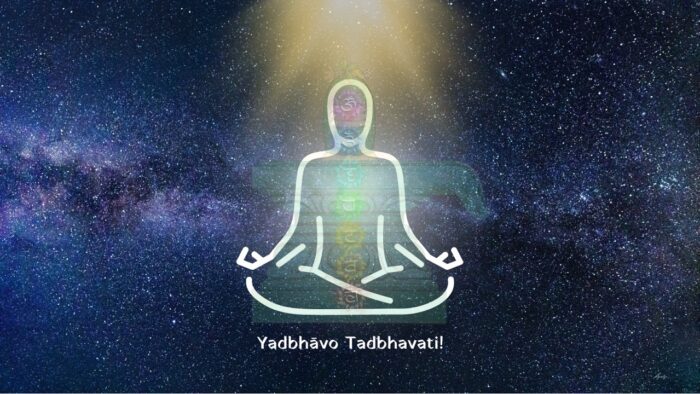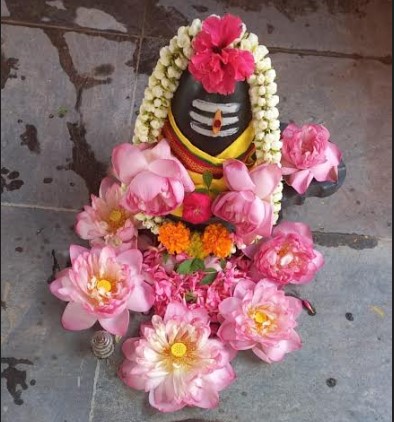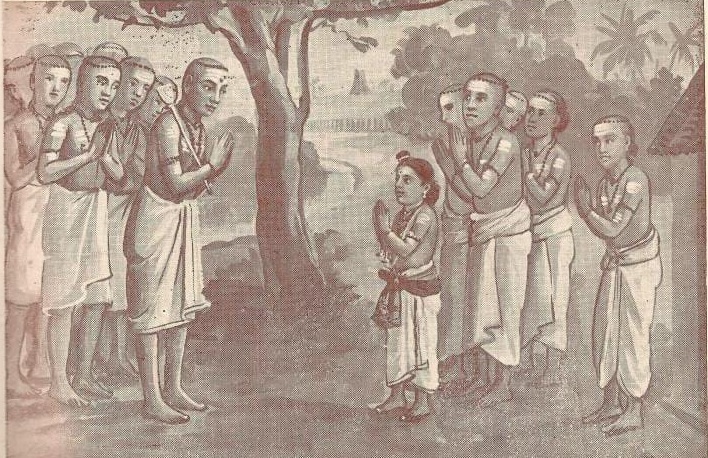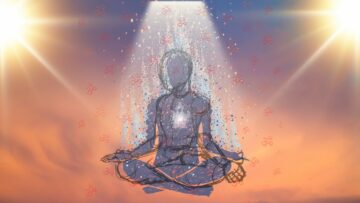Introduction
A model of Saguna Dhyanam & Upadrava Samanam
“Yen Ulame Puguntha Athanāl”
Yadbhāvo tadbhavati…As is the ideation, therein is the outcome. The power of the mind in influencing one’s choices and the outcomes has long been emphasized in Bhāratīya philosophy, especially so in the Yogasūtra.
It has also been emphasized to us even in the pursuit of daily tasks that one must always be affirmative in one’s thoughts, words and deeds rather than give way to doubt, fear and anxiety, for these render the mind vulnerable to all manner of duḥkha. As a potent tool of positive affirmation and anchoring, the bhakti tradition celebrates Īśvara praṇidhāna, building our lives on the twin pillars of īśvara prasāda buddhi and īśvara arpaṇa buddhi.
Both these aspects (positive affirmation and unflinching bhakti) are beautifully iterated by Saint Thirujñānasambandar, in his very well-known Thevāram, “Kolaru Pathigam.”This paper explores the Kolaru Pathigam in the light of the connection between the practice of dhyana with a śubha āsraya and the corresponding destruction of all kleśa-s and antarāya-s leading us to the revelation of the magnificent power of the Divine indwelling inspirer, Sadāśiva.
Understanding the process of dhyānam
Deśabandhaḥ cittasya dhāraṇā (Yogasūtra 3.1)
(Dhāraṇā (Concentration) is the fixing of the mind in one place)
Tatra pratyaya ekatānatā dhyānam (Yogasūtra 3.2)
(Dhyāna (meditation) is the one-pointed fixation of the mind in that place itself)
Tat eva artha mātra nirbhāsam svarūpaśūṇyam iva samādhiḥ (Yogasūtra 3.3)
(Samādhi is when that object alone shines forth as if the nature of the mind is verily absent)
According to Śivapurāna (Vāyavyasaṁhitā uttarabhāga 37.51b-53a),
Dhyai cintāyāṁ smr̥to dhātuḥ śvacintā muhurmuhuḥ
Adhyākṣiptena manasā dhyānam nāma taducyate
Dhyeyāvasthitacittasya sadr̥śaḥ pratyayaśca yaḥ
pratyayāntaranirmuktḤ pravāho dhyānamucyate
(The word dhyānam comes from dhyai which is to think. Repeated contemplation on Śiva with the mind free from confusion is dhyānam. Dhyānam is the continuous flow of the mind fixed on the object of meditation to the exclusion of all objects)
Dhyeye saktaṁ mano yasya dhyeyamevānupaśyati
Nānyaṁ padārthaṁ jānāti dhyānam etat prakīrtitam
Dhyeye mano niścalatāṁ yāti dhyeyaṁ vicintayan
Yattadhyānaṁ paraṁ proktaṁ munibhirdhyānacintakaiḥ (Garuḍapurāṇa)
(When he, whose mind is absorbed in the object of contemplation sees only that object and one other, that state is called dhyāna. When the mind becomes motionless in its absorption in the object of contemplation it is called perfect dhyānam)
Dhyānasya lakṣaṇam citannimeṣārdhamapi sphuṭam
Na pr̥thagjāyate dhyeyāddhāraṇāṁ yaḥ samāhitaḥ (Skāndapurāṇa)
(When a person who has taken up dhāraṇā does not get separated even for a moment, that becomes dhyana)
What can be chosen as an object for Dhyānam?
- Parabrahman (Mārkaṇḍeya Purāṇa)
- Sat – the Supreme unembodied Truth (Viṣṇupurāṇa)
Agnau kriyāvatāmapsu vyomni sūrye manīṣiṇām
Kāṣṭhādiṣveva mūr̥khānāṁ hr̥di liṅgaṁ tu yoginām
(Kūrmapurāṇa)
Arcāyāṁ sthaṇḍile’gnau vā sūrye vāpsu hr̥di dvije (Bhāgavatapurāṇa)
Insights on Dhyānam from T Krishnamacharya
According to T Krishnamacharya, dhyeya (object) is a must for dhyānam. The dhyeya could be the auspicious antaryāmi dwelling in the heart. The dhyeya could be in the navel or in the place between the eyebrows. It could also be in the brahmarandhra, or something outside like the sanctum sanctorum of ancient temples. The dhyeya could also be svayam vyakta vigraha. Dhyāna phala are twofold:
- dr̥ṣṭa phalam – birth of healthy children, wealth, prosperity, freedom from disease
- adr̥ṣṭaphalam – sukham, ānandam, ātmadarśanam
How should dhyānam be done?
Yadā śuddhā ca siddhāsyāt dhāraṇa hr̥daye dr̥ḍham
Deśe’nyasmin vigrahe vā sundare sr̥utisammate
Ārabheta tato dhyānaṁ ekasminviṣaye ciram
Cittapratyayarūpaṁ tat dyeyasākāramāvahet
(T Krishnamacharya’s Dhyānamālikā)
(Dhāraṇā must be focused with purity on the heart
Or a beautiful idol, as ordained in the Śāstra-s.
Begin dhyānam with the mind one pointed,
As the mind takes only the form of its focus).
Ādau pādau tadanu ca jañghe
Paścādūru nābhiṁ hr̥dayam
Dhyātvā bāhu sundaravapuṣaṁ
Sumukham lokaya gokulanātham
(T Krishnamacharya’s Dhyānamālikā)
(Begin from His feet,
Then move upwards towards his torso and heart.
Now, meditate on His beautiful arms,
Then look upon His charming divine face – that Lord of Gokula).
This method of meditation, moving from the feet to the head is also referenced in Thiruppāṇālvār’s Amalanādipiraṇ pasurams. Śrī Krishnamacharya adopts this method indicating that the path of dhyānam commences by forging a deep bond with the chosen form of the divine.
Saguṇa and Nirguṇa dhyānam
Yadā tadātvaṁ manvīthā
Samādhissaguṇo hi tat
Yadātatra bahirvastu
Vismr̥taṁ syāt viśeṣataḥ
(T Krishnamacharya’s Dhyānamālikā)
(When the mind completely
Merges with the Supreme (murti)
Nothing else remembered,
That indeed is saguṇa samādhi).
Dhyānaprayojanam
- Liberation from bondage and attainment of siddhi-s (Śivapurāṇa)
- Bestows both iha sukha and mukti (Śivapurāṇa)
- Leads to śānta and jñāna (Agnipurāṇa)
- Destroys both puṇya and apuṇya karma (Śivapurāṇā)
- Salvation, removal of all ignoble actions, earns the benevolence of the divine, helps to fulfill all aspirations (Nāradīyapurāṇa)
Dr̥ḍhayati cittaṁ janayati yogaṁ
Viśadī kurute viveka bhāvam
Vr̥ddhiṁ gamayatyātmānandaṁ
Kiṁ Vrddhi na dadātyamalaṁ dhyānam
(T Krishnamacharya’s Dhyānamālikā)
(Strengthening the mind, promoting the connection
With the Supreme, expanding discernment,
Sustaining the experience of ānanda,
There is nothing that is unobtainable though perfected dhyānam).
The Crux of the Kolaru Pathigam
While it is popularly held that reciting this Thevāram can dispel the negative effects of planets in unfavourable positions, when we delve deeper into the verses of this Pathigam, it immediately becomes apparent that what Thirujñānasambandar is emphasising is that when the mind is anchored firmly and unflinchingly in the ever-auspicious Parameśvara, then whatever occurs, however it occurs, will only herald auspiciousness in the life of the bhakta. Interestingly, he doesn’t say that nothing untoward will ever happen, but rather that when the mind is thus protected by the kavaca of śivabhakti, then everything is perceived only as the best and the most auspicious, and this state of mind in turn creates a shield of such power that all manner of distress is dispelled.
The Context of the Kolaru Pathigam and its Significance
Thirunāvukkarasar (Appar) and Thirujñānasambandar, who are contemporaries, meet at Thirumaraikadu kshetram. Their songs cause the temple doors that had been sealed shut to open and then close again, thus re-establishing the daily worship at the temple. Just then Queen Mangayarkkarasi sends an envoy requesting Thirujñānasambandar’s urgent presence at Madurai.
(Figure 1: Credit: Twitter – Thirunāvukkarasar (Appar) nayanar meeting Thirujñānasambandar on the way to Madurai)
As Thirujñānasambandhar prepares to embark on his journey to Madurai, Appar stops him saying that the planetary positions are not favourable for travel, and that he would have to journey through dark forests with hidden dangers and face other calamities en route.
Assuaging the much elder Appar, the young Jñānasambandar sings the Kolaru Pathigam, assuring him in every verse that nothing inauspicious can befall a Śivabhakta, for the object of his adoration, is nothing but the ever-auspicious Śiva.
In every verse of the Pathigam, the first two lines describe various forms of Śiva, emphasizing that this form divine must penetrate and pervade into one’s heart-space (yeṇ ulamey puguntha athanāl); the next two lines of every verse, proclaim with a heartening assurance that all forces of nature, and all inimical forces no matter how terrifying, usher in only what is beneficial, for they stand bound to the command of Īśvara, who protects his devotee beyond any doubt.
Among the thevaram-s, this is possibly the only Pathigam, where the words, “nalla Thevar am” implying “good” repeat so frequently in every stanza.
A point to be emphasized here is that Thirujñānasambandhar does not say that nothing untoward will ever happen, but rather that even inopportune moments and inimical forces will only bring/do good to the Śivabhakta, who is immersed in dhyana of parameśvara. This is borne out by events that do occur when Thirujñānasambandhar reaches Madurai, for the camp he is staying in, is set on fire. However, he and his entourage escape unharmed.
Here, what is highlighted is not just a passive surrender, born of helplessness, but an active and celebrative surrender, born of delight in the assurance that Parameśvara will indeed hold and nurture beyond any doubt. Here, the outpouring of an ardent and undiluted love for Īśvara and the readiness to align with Īśvara’s will at all times and in all situations is paramount, for this calls for transcending our fears and sorrows and actively shielding ourselves with Śiva nāma and Śiva svarūpa.
In recent history, the worship of the Navagraha and a keen following of their transitions has become the norm, with many often plagued by great anxiety when the planets move to unfavourable positions. The Kolaru Pathigam emphatically places not just the Navagraha but all possible forces of ill omen, disease, death turmoil beneath the overlordship of Śiva, affirming that when one’s heart is suffused with bhakti, then there is truly nothing to fear, for that very bhakti gives us the strength to face up to all challenges with clarity, resolution and unwavering conviction. Therein lies the fundamental difference, between a fear-based approach to life and a Śraddhā based approach to life.
Saguna Dhyānam and Kolaru Pathigam
In clarifying the difference between Dhyāna and Samādhi, Śrī T Krishnamacharya explains that they are a part of a continuous process, with dhyānam being the kāraṇām of samādhi, the kāryam.
What is also clearly indicated in the Yogaśutra (III.24) is that whatever the object one chooses to meditate upon, the sādhaka acquires the attributes of that object. This is in line with the yoga premise that the mind, when sufficiently trained has the potential to manifest anything. As Koelman says, “Man’s individual body and mind are only superficially and relatively individual substances, fundamentally they are only energizations and self differentiations of and within prakritic nature itself, which is the sole genuine substance. Man, therefore, through his prakritic organization, is in communication, is one with prakritic nature in its universality. (1970, 241)
Krishnamacharya explains that meditation is a process of Dhyeya ākāra āveśa – dhyānam is a process of immersing the mind in the object chosen to the extent that the nature of the mind as it were is lost and the object alone shines. Naturally, it follows that the need for a śubhāśraya therefore, is paramount. What āśraya can be more potent or transformative than the supreme Īśvara himself?
When it comes to our experience of unfortunate events and distress, often, the experience is exacerbated by the worry and anxiety one projects even before the event occurs, often due to the fear of this potential event. While jyotiṣa can help us navigate such untoward life events to some extent, there is nevertheless an underlying undercurrent of fear, that itself is counterproductive.
Śri Desikachar would often say, “Prabalena durbalasya bādhaḥ,” the negative saṁskāra-s that render one weak must be stringently overcome by creating strong, positive saṁskāra-s to replace them. This is one of the fundamental tenets in the Krishnamacharya approach to yoga and yoga therapy.
We see this beautifully emphasized in the Kolaru Pathigam, in which Jñānasambandar directs us to immerse our minds in Śiva alone for then as Śiva pervades our entire heart space, then that transformative power of Śiva itself bestows upon us the clarity of mind and the strength of will to face up to and overcome all manner of challenges.
Śiva as dhyeyam
According to the commentary of Abhinava Śaṅkarācārya, there are five aspects to the term, Śiva.
Tat karoti – śivaṁ Karoti – Śiva is the one who does Śiva
What is Śivam?
- Śivam is maṅgalam – the one who bestows goodness/auspiciousness
- Śivaṁ karaḥ – the one who bestows welfare on all
- Śivo’smi tena bhūtānām – the one who is impartial to all
- Manuṣyānāṁ śivaṁ icchati – the one who desires the welfare of all human beings (simply by his saṅkalpa, he desires welfare for all)
- Aśeṣakalyāṇanidhi – the one who is the repository of all noble virtues
Śyati arthāt nāśayati aśubhān iti śivaḥ explains Dr. Sampadananda Misra in one of his posts. Śiva is verily the one who being the embodiment of auspiciousness, transforms the sādhaka by removing from him/her all that is inauspicious and creates obstacles in inner progress. In our case, our foremost obstacle is the mind itself, for therein lies the source of our fears and hence, regression.
As Bhartr̥hari says, in the Vairāgya Śatakam, “Vairāgyam eva abhayam.” All engagements are fraught with fear – fear of change, fear of humiliations, fear of destruction, fear of loss and ultimately, fear of death. And so, when our vision is obscured by fear then everything is a source of distress. Here, Jñānasambandar tells us to anoint our eyes with the form of Śiva, smear our lips with his nāma and immerse the mind in His svarūpa, thereby invoking Śiva in every cell of our being. And where Śiva rules, all manner of auspiciousness, wellness and abundance follow.
The Rudrayāmala states,
Bhāvena vidyate sarvaṁ bhāvena devadarśanam
Bhāvena paramaṁ jñānaṁ tasmādbhāvālaṁbanam
(Meditating (with devotion) bestows everything, meditating confers the vision of the iṣṭadevata. Meditation leads to the highest knowledge and so, one must take recourse to meditation).
Let us now look at each verse of the Kolaru Pathigam to understand how such a saguṇā dhyānam builds resilience and acceptance in the mind. The translation closely follows the translation given by Sri P R Ramachander.
(Figure 2: Credits: Dreamstime – Sculpture of Shiva with His Consort Uma Maheshwari)
வேயுறுதோளிபங்கன்விடமுண்டகண்டன்
மிகநல்லவீணைதடவி
மாசறுதிங்கள்கங்கைமுடிமேல்அணிந்தென்
உளமேபுகுந்தஅதனால்
ஞாயிறுதிங்கள்செவ்வாய்புதன்வியாழன்வெள்ளி
சனிபாம்புஇரண்டும்உடனே
ஆசறுநல்லநல்லஅவைநல்லநல்ல
அடியார்அவர்க்குமிகவே.
Veyurutholipangan viḍamuṇḍakaṇḍan miganallavīṇai taḍavi
Māsaru thingal gangai muḍimelaninthu yen ul̥ame puguntha athanāāl
Jñāyiru thingal chevvai budhan vyāzhan vel̥l̥I sanipāmbirenḍum uḍane
Āsaru nalla Asatru avai nala nalla aḍiyāravarrku migave
(Sharing his body with Her of Bamboolike shoulders, blue-throated from the poison, playing on the Veena (at the time of pralaya), bearing on his head the spotless moon and the Ganga, has penetrated the depths of my heart; and so, the sun, moon, Mars, Mercury, Jupiter, Saturn and the two snakes (Rahu and Ketu), uproot my desires and are only good, they bring only good to the devotees of Siva).
என்பொடுகொம்பொடாமைஇவைமார்புஇலங்க
எருதேறிஏழைஉடனே
பொன்பொதிமத்தமாலைபுனல்சூடிவந்தென்
உளமேபுகுந்தஅதனால்
ஒன்பதுஒன்றொடுஏழுபதினெட்டொடுஆறும்
உடனாயநாள்கள்அவைதாம்
அன்பொடுநல்லநல்லஅவைநல்லநல்ல
அடியார்அவர்க்குமிகவே.
Enbodu kombodamai ivai marbilanga, erutheri ezhai udane,
Pon pothi matha maalai punal choodi vanthen ulame pugundha adanal,
Onbathodu ondrodu ezhu pathinettodu aarum udanaya natkal avai tham,
Anbodu nalla nalla Avai nalla nallaadiyaaravarkku migave.
(With his chest adorned with garland of bones, boar’s tusk and tortoise shell, he rides along with Parvathi on the bull
And also wearing garland of datura flowers with their golden pollen, his hair adorned with Ganga,
He has entered my heart and dwells there and so the inauspicious stars that are
Ninth, seventeenth, eighteenth and twenty fourth among the twenty seven,
Do only good and good with love, for they are good, good for the devotees of Siva).
உருவளர்பவளமேனிஒளிநீறணிந்து
உமையோடும்வெள்ளைவிடைமேல்
முருகலர்கொன்றைதிங்கள்முடிமேல்அணிந்தென்
உளமேபுகுந்தஅதனால்
திருமகள்கலையதூர்திசெயமாதுபூமி
திசைதெய்வமானபலவும்
அருநெதிநல்லநல்லஅவைநல்லநல்ல
அடியார்அவர்க்குமிகவே.
Uruvalarpavalameniolineeruaninthu, umayodumvellaividaimel,
Murugalarkondrai thingal mudimelaninthu yen, ulame pugundhu ,athanaal,
THirumagalkalayathoorthicheyyamathubhoomidisaideivamanapalavum,
Aruneri nalla nalla Avai nalla nallaadiyaaravarkku migave.
(With his glowing radiant coral like body wearing the shining holy ash.
Along with Goddess Parvathi on the white bull, wearing the golden kondrai flowers
As well as the crescent on his head, he has entered into my heart and so,
The Goddess Lakshmi, Durga, mother earth and the various deities guarding the directions
usher in good and good with love, for they are good, only good for the devotees of Shiva).
மதிநுதல்மங்கையோடுவடபால்இருந்து
மறையோதும்எங்கள்பரமன்
நதியொடுகொன்றைமாலைமுடிமேல்அணிந்தென்
உளமேபுகுந்தஅதனால்
கொதியுறுகாலன்அங்கிநமனோடுதூதர்
கொடுநோய்களானபலவும்
அதிகுணம்நல்லநல்லஅவைநல்லநல்ல
அடியார்அவர்க்குமிகவே
Mathinuthalmangayoduvadaaalirunthumaraiothumengalparaman,
Nathiyodukondraimalaimudimelanithu yen ulame pugundhuathanal,
Kothiyurukalananginamanodudootharkodunoygalaanapalavum,
Athiguna nalla nalla Avai nalla nallaadiyaaravarkku migave
(With the lady with the crescent like forehead sitting below a banyan tree and teaching Vedas,
Our God wears on his head kondrai flowers along with the river and has entered my heart and so, the vengeful god of death along with his messengers and also various horrific diseases, do only good and good with love, for they are good, good for the devotees of Shiva).
நஞ்சணிகண்டன்எந்தைமடவாள்தனோடும்
விடையேறுநங்கள்பரமன்
துஞ்சிருள்வன்னிகொன்றைமுடிமேல்அணிந்தென்
உளமேபுகுந்தஅதனால்
வெஞ்சினஅவுணரோடுஉருமிடியும்மின்னும்
மிகையானபூதம்அவையும்
அஞ்சிடுநல்லநல்லஅவைநல்லநல்ல
அடியார்அவர்க்குமிகவே
Nanju ani kandanyendhaimadavaalthanodum, vidayeruthangalparaman,
Thunjirulvannikondraimudimelaninthu, yen ulame pugundha adhanal,
Venchinaavunarodum, urumudiyumminnummigayanabhoothamavayum
Anjidum nalla nalla Avai nalla nallaadiyaaravarkku migave
(My father, his neck decorated with the poison, riding along with Parvati on the bull, who wears vanni leaves and kondrai flowers (upon his head) has entered my heart and so, the angry asuras, roaring thunder, lightning and those vile creatures that we are afraid of, do only good and good with love, for they are good, good for the devotees of Shiva).
வாள்வரியதளதாடைவரிகோவணத்தர்
மடவாள்தனோடுஉடனாய்
நாள்மலர்வன்னிகொன்றைநதிசூடிவந்தென்
உளமேபுகுந்தஅதனால்
கோளரிஉழுவையோடுகொலையானைகேழல்
கொடுநாகமோடுகரடி
ஆளரிநல்லநல்லஅவைநல்லநல்ல
அடியார்அவர்க்குமிகவே
Valavariathalathadaivarikovanatharmadavaalthanodumudanay,
Naanmalarvannikondrainadhi choodi vandhuen ulame pugundhuathanal,
Kolari uzhuvayodukolaiyanaikezhalkodunagamodukaradi,
Alari nalla nalla Avai nalla nallaadiyaaravarkku migave
(Wearing the striped skin of the tiger and the loin cloth, and along with Parvathi, adorned vanni leaves and kondrai flowers has penetrated into my very heart. So, tigers of fearsome power, murderous elephants, boars, cobras, bears and lions,
do only good and good with love, for they are good, good for the devotees of Shiva).
செப்பிளமுலைநல்மங்கைஒருபாகமாக
விடையேறுசெல்வன்அடைவார்
ஒப்பிளமதியும்அப்பும்முடிமேல்அணிந்தென்
உளமேபுகுந்தஅதனால்
வெப்பொடுகுளிரும்வாதமிகையானபித்தும்
வினையானவந்துநலியா
அப்படிநல்லநல்லஅவைநல்லநல்ல
அடியார்அவர்க்குமிகவே
Cheppilamulai nan mangaiorubhagamagavidaiyeruchelvanadaivaar,
Oppilamathiyumappummudimelaninthen ulame puganthaathanaal,
Veppodukulirumvadammigayanapithum , vinayanavandhunaliyaa,
Appadi nalla nalla Avai nalla nallaadiyaaravarkku migave
(Sharing one side of his body with the well bosomed damsel , he is the source of all wealth,
bearing on his head , the incomparable moon as well as the river, he has penetrated my very heart, and so fevers with chills, rheumatic aches, and bilious plaints which come and trouble do only good and good with love, for they are good, good for the devotees of Shiva).
வேள்படவிழிசெய்துஅன்றுவிடைமேல்இருந்து
மடவாள்தனோடும்உடனாய்
வாள்மதிவன்னிகொன்றைமலர்சூடிவந்தென்
உளமேபுகுந்தஅதனால்
ஏழ்கடல்சூழ்இலங்கைஅரையன்தனோடும்
இடரானவந்துநலியா
ஆழ்கடல்நல்லநல்லஅவைநல்லநல்ல
அடியார்அவர்க்குமிகவே
Vel pada vizhicheythanruvidaimelirunthumadavalthanodumudanay,
Van mathivannikonrai malar choodi vandhen ulame pugundhuadhanaal,
Ezhkadalchoozhilangaiarayanthanodumidaranavandhunaliyaa,
Aazhkadal nalla nalla Avai nalla nallaadiyaaravarkku migave
(With his fiery eye he burnt Manmatha when he shot an arrow, and along with Parvathi he rides the bull,
And wearing the crescent of the sky, Vanni leaves and Kondrai flowers, he penetrated my heart, and so the king of Lanka which is surrounded by the seven seas and other afflictions surrounding the sea, do only good and good with love, for they are good, good for the devotees of Shiva).
பலபலவேடமாகும்பரனாரிபாகன்
பசுவேறும்எங்கள்பரமன்
சலமகளோடுஎருக்குமுடிமேல்அணிந்தென்
உளமேபுகுந்தஅதனால்
மலர்மிசையோன்மால்மறையோடுதேவர்
வருகாலமானபலவும்
அலைகடல்மேருநல்லஅவைநல்லநல்ல
அடியார்அவர்க்குமிகவே
Pala palavedamagumparanaaribhagan, vasuverumyengalparaman,
Chalamagaloduerukkumudimelaninthu yen ulame pugundhuadhannal,
Malar misayonum malum maraiyodudevarvarukalamanapalavum,
Alaikadalmeru nalla nalla Avai nalla nallaadiyaaravarkku migave
(Assuming many forms, the consort of Parvathi who is our lord rides on a bull,
And wearing the erukku flower on his head, he penetrates my heart, and so Lord Brahma, Vishnu, the Vedas, Devas and other things yet to come, do only good and good with love, for they are good, good for the devotees of Shiva).
கொத்தலர்குழலியோடுவிசையற்குநல்கு
குணமாயவேடவிகிர்தன்
மத்தமும்மதியும்நாகம்முடிமேல்அணிந்தென்
உளமேபுகுந்தஅதனால்
புத்தரோடுஅமணைவாதில்அழிவிக்கும்அண்ணல்
திருநீறுசெம்மைதிடமே
அத்தகுநல்லநல்லஅவைநல்லநல்ல
அடியார்அவர்க்குமிகவே
Kothaalarkuzhaliyoduvisayarnalgugunamaaivedavigithan,
Mathamummadhiyanagammudimelaninthen ulame pugundhuadhanal,
Putharoduamanavathilazhivirkkumannanthiruneeruchemmaithidame,
Athagu nalla nalla Avai nalla nallaadiyaaravarkku migave
(Along with the pretty lady wearing flowers, that multifaceted God of the Vedas went to give a boon to Arjuna, adorned with datura flowers, moon and the serpent, he entered my heart.
His sacred ash (vibhoothi) will defeat the opposing Baudhas and Jainas without any doubt and, do only good and good with love, for they are good, good for the devotees of Shiva).
தேனமர்பொழில்கொள்ஆலைவிளைசெந்நெல்துன்னி
வளர்செம்பொன்எங்கும்நிகழ
நான்முகன்ஆதியாயபிரமாபுரத்து
மறைஞானஞானமுனிவன்
தானுறுகோளுநாளும்அடியாரைவந்து
நலியாதவண்ணம்உரைசெய்
ஆனசொல்மாலையோதும்அடியார்கள்வானில்
அரசாள்வர்ஆணைநமதே!!
Thenamarpozhi kola alai vilaichennel, thunnivalarchembonengumthigaza,
Naan muganaadhiyayabiramapurathumarai Jnana Jnanamunivan,
Thanurukolunaalumadiyaraivandhunaliyathavannamuraichei,
Aanachol maalai oodhumadiyargalvaanilarasalvraanainamathe.
(The saint Thirujñānasambandar of Brahma puram , where Brahma is worshipped,
And which has honeybees, sugarcane and paddy in an abundant measure,
orders that those devotes who read this garland of words,
Would not suffer the ill effects caused by planets, stars and other such forces and are certain to rule the heavens!
Thus ends this pathigam, as Sambandarro claims with utmost affirmation that those who hold and cherish the form of Siva in their heart’s heart, need not fear anything, for Siva dhyanam transforms the most fearful mind into one that is at all times equanimous and ready to align itself to the Lord’s will. On a parallel thought, the Yogasūtra iterates the same idea in sutra 2.28 – Yogāṅgānuṣṭhānātaśuddhikṣayejñānadīptiḥāvivekakhyāteḥ.
Here, the path of yoga culminating in samādhi has the power to remove all impurities of the mind and kindle the lamp of wisdom within. This is also the intuitive wisdom and assurance that is inspired by the Kolaru Pathigam.
References
- Sekkilaar, and G. Vanmikanathan. Periya Puranam — A Tamil Classic On The Great Saiva Saints of South India. Ed. Dr. N. Mahalingam. Chennai: Sri Ramakrishna Math, 2000.
- Sivananda, Swami. Sixty-Three Nayanar Saints. World Wide Web edition. India: Divine Life Society, 1999.
- http://stotrarathna.blogspot.com/2012/01/kolaru-thirupathigamtamil.html
- http://www.skandagurunatha.org/deities/siva/thirumurai/thevaram-2.085-kolaru-thiru-pathigam.pdf (for English translation)
- The Heart of Yoga, TKV Desikachar
- The Yogasutras of Patanjali, Edwin S Bryant, North Point Press
- Yoga in the Mahauranas, BORI Publication
- Personal Study between 2002 and 2012 with Sri TKV Desikachar
- Personal study of the Kolaru Pathigam with Kalaimamani Smt. Krishnakumari Narendran, between 2014 and 2015.
- Personal sadhana as a disciple of PujyashriMAthajiVithamma, Sri Muthukrishna Swami Mission Trust, Vallioor
Watch video presentation of the above paper here:
Disclaimer: The opinions expressed in this article belong to the author. Indic Today is neither responsible nor liable for the accuracy, completeness, suitability, or validity of any information in the article.












